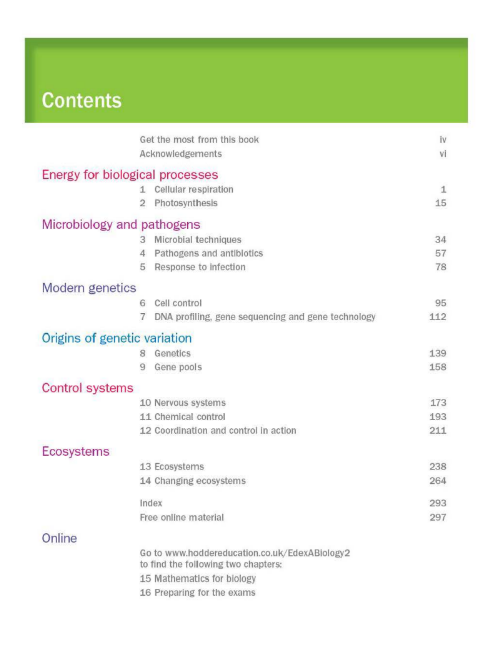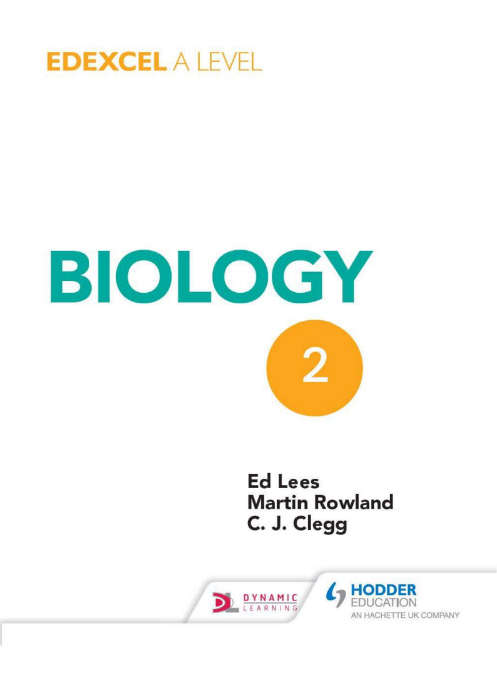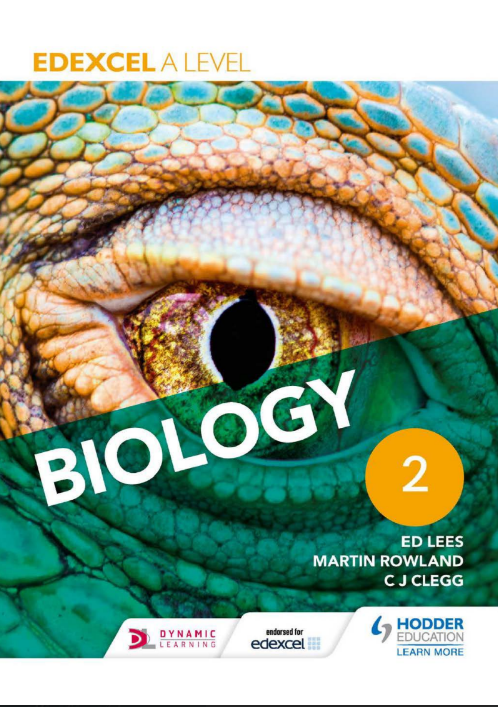


Acknowledgements
The Publisher would like to thank the following for the following to reproduce copyright material.
Photo credits:
© Dr Kari Lounatman/Science Photo Library; p.21 © Dr Kenneth R. Miller/Science Photo Library; p.35 © Dr Jeremy Burgess/Science Photo Library; p.38 © Dr Linda Stannard, UCT/Science Photo Library; p.39 © Doncaster And Basselaw Hospitals/Science Photo Library; p.40 (both) © Trevor Clifford Photography/Science Photo Library; p.42 © John Durham/Science Photo Library; p.46 © Amelie-Benoist/Bsip/Science Photo Library; p.47 © Martyn F. Chillmaid/Science Photo Library; p.50 © Amelie-Benoist/Bsip/Science Photo Library; p.58 © Kwanghin Kim/Science Photo Library; p.59 © Juergen Berger/Science Photo Library; ↳ © Cnri/Science Photo Library; p.60 © Eye Of Science/Science Photo Library; ↳ © Simon Fraser/Science Photo Library; p.65 © Dr Linda Stannard, UCT/Science Photo Library; p.68 © Yue Jin/UK Department of Agriculture/Science Photo Library; p.69 © Nick Gregory /alamy; p.71 © Dr. Pete Billingsley, University of Aberdeen/Sinclair Stammers/Science Photo Library; p.79 © Steve Gschmeissner/Science Photo Library; p.80 © Steve Gschmeissner/Science Photo Library; p.86 © Steve Gschmeissner/Science Photo Library; p.96 ↳ and © Gary Mezzatros/Science Photo Library; ↳ © Gilles Merma/Science Photo Library; p.103 © Biophoto Associates/Science Photo Library; p.115 © UK Crown Copyright Courtesy Of Fera/Science Photo Library; p.122 © David Parker/Science Photo Library; p.131 © Matt Meadows/Photo Library/Getty Images; p.133 © Nigel Catlin/Science Photo Library; p.133 © Janice and Nolan Brand / Alamy; p.148 © Solvin Zankl/Visuals Unlimited, Inc./Science Photo Library; p.165 © ImageState Media (John Foss); p.166 © Dave Warts / Alamy; p.169 © Peter Falkner/Science Photo Library; p.174 © Gene Cox Estate; p.175 © Gene Cox Estate; p.180 © Gene Cox Estate; p.187 © Prof S. Cinti/Science Photo Library; p.190 © NHPA/Photoshot; p.194 ↳ © Vladimir Melnik – Fotolia, ⇦ © Nazz-Fotolia, ⇦ © ZambeziShark/Stock/Thinkstock, ↳ © Marcelo Sanchez – Fotolia, ↳ © Faulkes/Stock/Thinkstock; p.202 © Ross Koning; p.213 © Gene Cox Estate; p.226 © P&B, Fotos – www.superstock.com; p.233 © Jim Zipp/Science Photo Library; p.239 © Noaa Pinel Vents Program/ Science Photo Library; p.248 © Christian Guy/IMAGEBROKER – www.superstock.com; p.256 © G A Matthews/ Science Photo Library; ↳ © Glennis Moore/Science Photo Library; p.263 © Marshall Ikonography / Alamy; p.267 ↳ © Marvin Dembinsky Photo Associates / Alamy, ↳ © Martin Harvey/Alamy, ↳ © If Premaphotos / Alamy, ↳ © R.M Floral / Alamy; p.268 © Biophoto Associates/Science Photo Library; p.278 © Greg Arthur, © Nature Picture Library/ Alamy; p.279 © Frederick William Wallace/National Geographic Creative/Corbis, ↳ © Pierre Gleizes / Greenpeace; p.280 © Greenpeace; p.281 © Marine Stewardship Council; p.286 ↳ © Dr Ian Fuller, Massey University; p.287 © Georgette Douwma/Science Photo Library.
i = top, b = bottom, l = left, r = right, m = middle
Every effort has been made to trace all copyright holders, but if any have been inadvertently overlooked, the Publisher will be pleased to make the necessary arrangements at the earliest opportunity.
Cellular respiration
Prior knowledge
In this chapter you will need to recall that:
- chemical reduction involves the gain of electrons
- chemical oxidation involves the loss of electrons
- hydrogen atoms have one proton and one electron
- hydrogen ions have just one proton and hence are positively charged
- ATP and ADP molecules are used to transfer energy within cells
- mitochondria are the sites of ATP formation
- glucose is the most common respiratory substrate
- energy is neither created nor destroyed but simply transformed from one form into another
- aerobic respiration yields more ATP than anaerobic respiration
- the end products of aerobic respiration are carbon dioxide, water and ATP.
Test yourself on prior knowledge
1 State why reactions are referred to as REDOX reactions rather than simply oxidation or reduction.
2 We very rarely find hydrogen atoms moving around freely. Why is this?
3 Explain why ATP is described as the ‘energy currency’ of the cell.
4 Galactose is a 6-carbon monosaccharide with the formula C6H12O6. Whilst this is the same as glucose, many organisms cannot use galactose as a respiratory substrate. Explain why this is the case.
5 State the most common form of energy, apart from chemical energy, found in an actively respiring cell.
6 State what other compounds form respiratory substrates in animals apart from glucose.
Aerobic respiration
Key term
Aerobic respiration
The chemical breakdown of substrates in cells to release energy in the form of ATP when oxygen is present.
Organisms require energy to maintain all their living cells and to carry out their activities and functions. Respiration is the process by which that energy is transferred in usable form. Cellular respiration that involves oxygen is described as aerobic respiration. Most animals and plants and very many microorganisms respire aerobically, if not all of the time.
In aerobic respiration, sugar is oxidised to carbon dioxide and water and much energy is made available. The steps involved in aerobic respiration can be summarised by a single equation. Note that this equation is a qualitative statement of the inputs (the raw materials) and outputs (the products), but it tells us nothing about the steps.
Glucose + oxygen → carbon dioxide + water + energy
C6H12O6 + 6O2 → 6CO2 + 6H2O + energy
Đây là toàn bộ nội dung từ các hình ảnh bạn cung cấp:
This gives us the products shown in Table 1.1.
Table 1.1 Net products of aerobic respiration of glucose at the end of the Krebs cycle
| Step | CO₂ | ATP | Reduced NAD | Reduced FAD |
| Glycolysis | 0 | 2 | 2 | 0 |
| Link reaction (pyruvate → acetyl CoA) | 2 | 0 | 2 | 0 |
| Krebs cycle | 4 | 2 | 6 | 2 |
| Totals | 6 | 4 | 10 | 2 |
As you can see, this table shows a very small yield of ATP but a large yield of reduced NAD and some reduced FAD. The final stage of aerobic respiration explains how these reduced coenzymes can be converted into ATP and exactly how the remaining product, water, is formed.
Test yourself
5 State which final product of respiration is generated in the link reaction and Krebs cycle.
6 Describe where exactly in the cell the reactions of the link reaction and the Krebs cycle take place.
7 Describe how reduced NAD is formed in the link reaction.
8 Explain why NAD and FAD are known as coenzymes.
9 The Krebs cycle completes the breakdown of glucose molecules. Explain why the ATP yield is so low.
3 Oxidative phosphorylation and terminal oxidation
This section depends on your knowledge of mitochondrial structure, which you met in Chapter 4 of Edexcel A level Biology 1, Figure 4.6. It is important that you look back at your notes before continuing.
The removal of pairs of hydrogen atoms from various intermediates of the respiratory pathway is a feature of several of the steps in glycolysis and the Krebs cycle. On most occasions, oxidised NAD is converted to reduced NAD, but in the Krebs cycle it is an alternative hydrogen-acceptor enzyme known as FAD that is reduced.
In this final stage of aerobic respiration, the hydrogen atoms (or their electrons) are transported along a series of carriers, from the reduced NAD (or FAD), to be combined with oxygen to form water. Hence, the role of oxygen in this process is that of the final hydrogen acceptor. Note that this final reaction to form water only occurs after the energy level has been lowered by a series of transfers between carriers, bringing about the gradual transfer of energy shown in Figure 1.1.
As electrons are passed between the carriers in the series, energy is transferred. Transfer of energy in this manner is controlled and can be used by the cell. The energy is
Tip
Before attempting to understand this section, make sure you are very clear about hydrogen ions and atoms.
Hydrogen atoms lose their lone electron so a hydrogen ion is left as a proton. This is why you will see H+ and proton as alternatives in this diagram. The electron moves down a chain of carriers.
Anaerobic respiration or fermentation
In the absence of oxygen, many organisms (and sometimes certain tissues in organisms when deprived of sufficient oxygen) will continue to respire by a process known as fermentation or anaerobic respiration, at least for a short time.
Key term
Anaerobic respiration
The process by which substrates are broken down in cells to release energy in the form of ATP in the absence of oxygen.
A knowledge of aerobic respiration shows us that the effect that a lack of oxygen will have. If oxygen is the final hydrogen acceptor, then without it the consequences of oxidative phosphorylation will all become reduced and the flow of electrons and protons will cease. This will also mean that the supply of NAD+ will be halted and the Krebs cycle will also come to a stop.
With only glycolysis operating, you can see that there is a net gain of only 2 ATPs per glucose molecule compared with about 38 ATPs from complete aerobic respiration. Therefore, whilst aerobic respiration can continue without oxygen it is a very inefficient process.
A second consequence of a lack of oxygen is that the end-product of glycolysis, pyruvic acid, will begin to accumulate. As the concentration of pyruvic acid increases it is channelled into other biochemical pathways, as shown in Figure 1.8. In animal cells this results in the formation of lactate (lactic acid) as the pyruvate acts as the acceptor for reduced NAD, whilst in plant cells ethanol acts as this acceptor and this results in the formation of ethanol. In effect these compounds are replacing oxygen in the final hydrogen acceptor to allow glycolysis to continue.
Both lactate and ethanol contain large quantities of chemical energy, indicating that the glucose has only been partially broken down and explaining the low ATP yield.
Figure 1.8 The respiratory pathways of anaerobic respiration
[Diagram showing the breakdown of glucose through glycolysis to pyruvate, and then branching into aerobic respiration, alcoholic fermentation (producing ethanol and CO2), and lactate fermentation (producing lactate).]
Anaerobic respiration in vertebrate muscle
Active vertebrate muscles have a high oxygen demand. They will continue to work at a high rate their demand for oxygen quickly exceeds the maximum rate of supply. In order to continue working, the muscles need to respire anaerobically. If this is the case that the concentration of oxygen will begin to rise. The effect of this lactate is to gradually inhibit the muscle contractions.
You are probably familiar with this effect. If you begin to sprint, you will quickly begin to experience lactate build up in your muscles and the effect we know as fatigue. No matter how much you try to run faster, your muscles will not respond, and then begin to feel painful.
Đây là toàn bộ nội dung được trích xuất từ các hình ảnh bạn cung cấp:
Photosynthesis
Prior knowledge
In this chapter you will need to recall that:
- green plants are able to manufacture sugars using light energy, carbon dioxide and water
- oxygen is a waste product of photosynthesis
- several stages of photosynthesis take place in cell organelles called chloroplasts
- light is absorbed by plant cells using pigments such as chlorophyll
- colours of light are determined by different wavelengths
- photosynthesis using sunlight energy is the starting point for the large majority of food chains
- plants need to respire to produce ATP for cellular processes; photosynthesis produces the respiratory substrates required.
Test yourself on prior knowledge
1 State where chlorophyll molecules are attached in chloroplasts.
2 Explain why a solution of ink will appear blue when white light is shone through it.
3 If photosynthesis produces sugars that are respired to produce ATP, why must many plants accumulate large food stores.
4 Explain why many plant cells have food stores consisting of starch rather than sugars.
5 Name the organisms that cause the Earth’s oceans to be a major contributor to atmospheric oxygen.
Photosynthetic pigments
The purpose of photosynthetic pigments is to absorb light energy and convert it into chemical energy. Higher plants have two types of pigments – chlorophylls and carotenoids. The most important pigments are the chlorophylls, which play a direct role in the first stages of photosynthesis. Chlorophylls absorb light energy, which is passed on to chlorophyll; so they are called accessory pigments. Other plants such as marine algae (seaweed) have other accessory pigments. Some common photosynthetic pigments are listed in Table 2.1.
Key term
Accessory pigments
Light-absorbing molecules that pass on the energy they absorb to chlorophyll molecules at the start of photosynthesis.
Table 2.1 Common photosynthetic pigments
| Chlorophylls | β-carotene (orange) | Others |
| Chlorophyll a (green) | Xanthophyll (yellow) | Phycoerythrin (red) |
| Chlorophyll b (green) | Fucoxanthin (brown) |
chlorophyll a absorbs most strongly at 430 nm and 450 nm, whilst chlorophyll b absorbs most strongly at 470 nm. In this way, a combination of two or more pigments means that a greater range of wavelengths can be absorbed efficiently. You can see a very similar pattern at the red end of the spectrum. Almost all plants use chlorophylls as their primary pigments at the start of photosynthesis but the range of accessory pigments can vary considerably depending upon their habitat.
Test yourself
1 Suggest why the hydrocarbon chains of chlorophyll molecules will attach themselves easily to chloroplast membranes.
2 Describe how the ‘heads’ of chlorophyll molecules are adapted to the wavelength of light.
3 State which colour of light in the visible spectrum has the longest wavelength.
4 Describe what happens to the energy trapped by accessory pigments.
Core practical 11
Investigate the presence of different chloroplast pigments using chromatography
Background Information
Chromatography is a very common technique used in biochemistry to separate and identify small quantities of different compounds. There are many different variations but all work on similar principles.
The process involves a stationary phase – the chromatogram, which will be paper or a glass/plastic sheet in paper chromatography, or a solid/liquid in thin layer chromatography. In each case the mixture to be separated is loaded on to the stationary phase as a small spot and allowed to dry. The edge of the paper or other medium is then dipped in a solvent, which will be drawn up through the spot by capillary. The different compounds in the mixture will have different solubilities in the solvent and will interact with the stationary phase in different ways, so will move up the paper at different rates. As part of this interactive process, it is usually necessary to ensure the chromatogram is surrounded by solvent vapour by keeping it in a container.
If the compounds are coloured then it is easy to find the bands or spots formed on the complete chromatogram. If they are not then some other treatment will be necessary such as staining or viewing them under UV light.
Carrying out the practical
Aim: To identify the pigments present in an extract of plant leaves.
Risk assessment: The solvents used in this investigation, propanone and petroleum ether, produce highly flammable heavy vapours. These can spread unseen along benches so there should be no other naked flames in the laboratory during their use. Both solvents produce potentially harmful vapours, which should not be inhaled. Filling of chromatography vessels should be carried out in a fume cupboard. In addition, you must wear your own goggles. Gloves may be advisable if you have sensitive skin.
1 To prepare the extract for chromatography you will need to collect leaves of a plant that have a dark green colour. Sof leaves such as spinach, which are easier to crush, are ideal.
2 Cut the leaves into small pieces with scissors and place them into a small mortar with a sprinkling of fine sand.
3 Use a pestle to grind the leaves into a fine paste. Add a small amount of propanone to the paste as you grind. Keep the volume of propanone as low as you can to make sure your extract is as concentrated as possible.
4 Allow the mixture to settle and then blow off the dark green chlorophyll mixture with a small pipette. Place this in a small sealed test tube and allow any solids to settle. The mixture can be filtered but you will need to add even more propanone as some is absorbed by the filter paper.
5 To prepare the chromatogram for loading, cut a piece of chromatography paper to fit the container, you are to use. Use a pencil to draw a line about 1 cm from the bottom of your paper as shown in Figure 2.3, on the next page.
6 Assemble your chromatogram inside the container and make a spot on the line to indicate the level of solvent you will need to add. This should be sufficient to cover the end of the paper but it must not touch the spot of extract you are about to load onto it.


